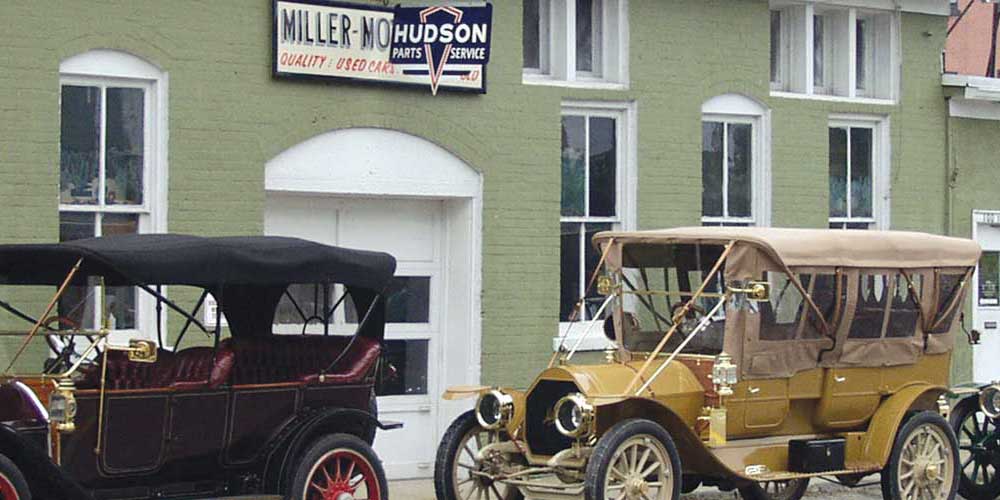By: Robert Tate, Automotive Historian/Researcher
Images: Courtesy of the National Automotive History Collection
Posted: 08.05.2015
One of the most gifted and talented designers of all time was the late Gordon Buehrig (1905-1990).
He was a great man with amazing talent that many people from all over the world enjoyed. Buehrig was born on June 18, 1904 in Mason City, Illinois. As a young man, he was fascinated by automobiles. Buehrig had spent a year at Bradley College in Peoria, Illinois and later became acquainted with many auto body building firms in Chicago.
His automotive design career began in the early 1920s. Buehrig’s career began when he joined the Gotfredson Body plant team located in Wayne, Michigan. Later, his journey continued with body design engineering that he learned from the Willis St. Clair, Jewetts and Peerless automobiles.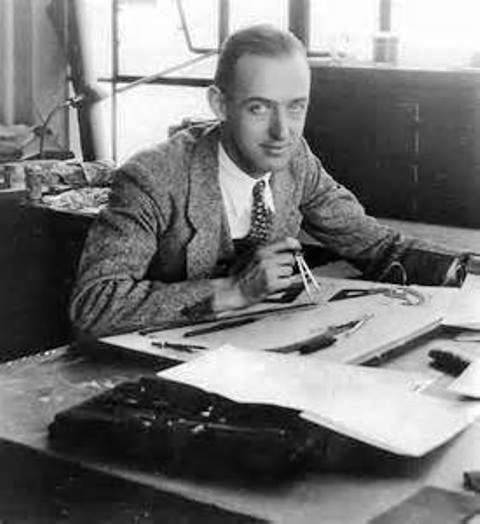 Gordan Beuhrig, Designer
Gordan Beuhrig, Designer
On Jan. 16, 1927, Buehrig started working for Packard making drawings for body panels. As his journey would continue, Buehrig was hired by the late Harley Earl of General Motors to be assigned within the “Art and Colour” department at General Motors. In 1928, at the age of 24, he became chief body designer for the Stutz Motor Car Company.
Buehrig had this to say about leaving General Motors and starting with the Stutz Motor Car Company, “I was a very naive young man. I was not smart enough to realize the fortunate position I was in at General Motors. I quit a few months after joining them to take a job as the body designer for the Stutz Motor Car Company of America in Indianapolis, Indiana. I left the largest and strongest automobile company to work for a small company which was in financial trouble and as history proved, had only a short time to live.”
A year later, he became chief designer for Duesenberg which had one of the most prestigious automobiles during the 1920s and 1930s. Harold T. Ames was vice president of Duesenberg Inc. when he interviewed Gordon Buehring in June 1929 for the position of chief designer. (see Duesenberg story “Remembering the Legacy of Frederick’s Duesenberg” 9/11/14)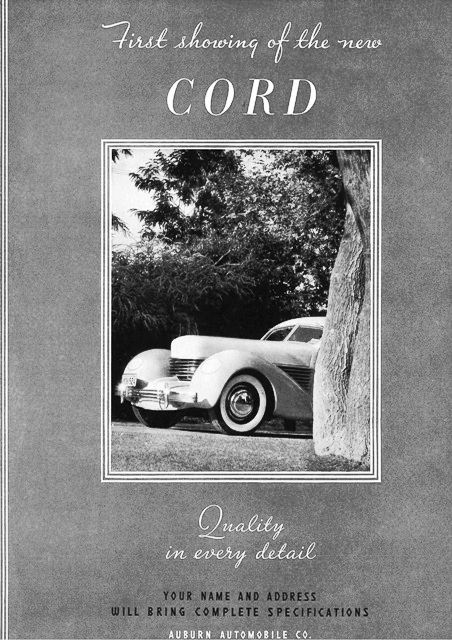 Cord Invitation
Cord Invitation
Buehrig’s most memorable and great automotive achievements, however, came when he started designing the 1935 Cord 810 model. The model was the hit of the New York Auto show. The 810 model featured front wheel drive along with flip-up headlights. The Cord 810/812 models were some of the best designed automobiles in the world.
Unfortunately, problems were created for the Cord because of the Great Depression, long delays between introduction and production, early mechanical problems, and scrambling to survive the declining market. The first Cord model was originally designed as a baby Duesenberg. However, the car became a Cord model when the front wheel drive was decided upon in order to make for a lower silhouette designed.
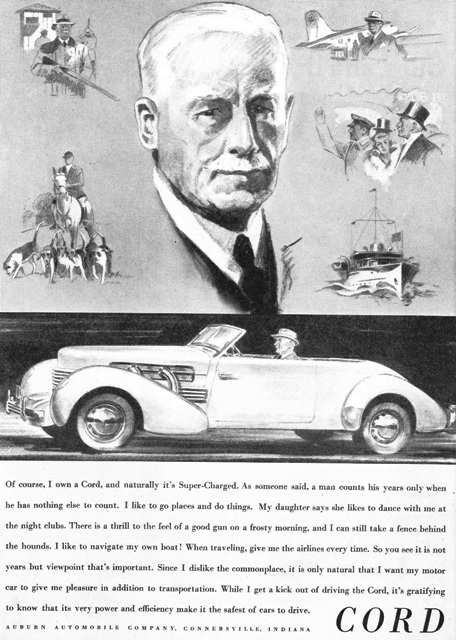 Advertising for Cord
Advertising for Cord
On May 17, 1934, Buehrig filed for a patent on his design of the smaller Duesenberg and the patent was issued Oct. 2, 1934. The design was naturally assigned to the Cord Corporation and later became the starting point for the Cord 810 models. Buehrig and his great staff at the time included Vince Gardner, Dale Cosper, Bill Robinson and Bart Cotter, who were all a part of the great design team that built a three dimensional scale model in clay.
As the men worked on the Cord design project, they used the “styling bridge," an invention that was used to create this great design. The styling bridge later became a common tool that was used in every day designs in all automobiles studios on both full size and scale model design work.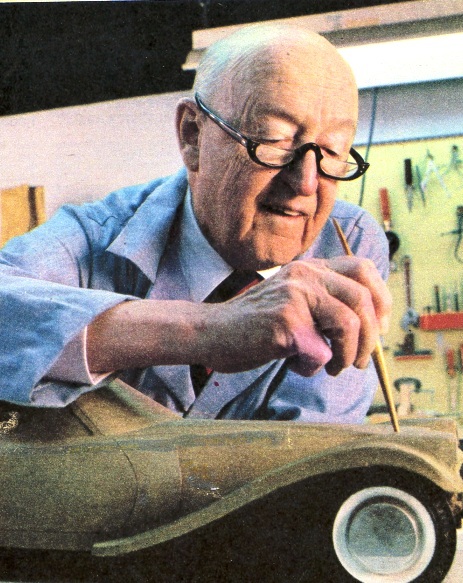 The Last Picture of Gordon Buehrig
The Last Picture of Gordon Buehrig
The Cord automobile was completely in accord with the very highest standards of beauty and good taste. After the Cord Corporation folded, Buehring left the Auburn Automobile Co. and joined the Detroit office of the Edward G. Budd Mfg. Co and began working on a small prototype design vehicle.
Buehrig also became a part of Raymond Lowey’s Studebaker team that helped design and shape the 1947 models. Later in 1949, Buehrig started working at Ford Motor Co. (1949-1965) under the direction of John Oswald, who was the head of body engineering and styling. His first assignment was the 1951 Ford hardtop designs and later the first all steel 1952 Ford station wagon models in addition to the Continental Mark II project. He was involved with the Ford Falcon up until his retirement.
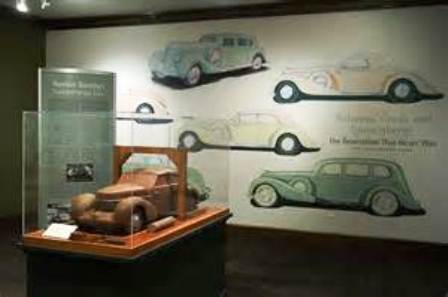 Exhibit for Gordon Buehring
Exhibit for Gordon Buehring
Buehrig, later taught at the Art Center College of design in Los Angeles from 1965-1970. In 1972, he went back to the drawing board to design what was to become the first car to ever bear his name, The Buehrig Motor Car Company. In 1981, Buehrig was selected by the Society of Automotive Historians as one of the industry’s thirty most significant people internationally.
On a final note, Buehrig once said, “The most newsworthy thing I could talk about as far as my being a unique individual is that I’ve got a one track mind. I always have had. I’m just as enthused about cars now as I was 60 years ago." Buehrig has received a long list of great awards. Gordon Buehrig will always be a great part of automotive history as he leaves the world a great legacy.
A special thanks to Robert Tate, Automotive Historian and Researcher, for donating the story to the MotorCities Story of the Week program. Photographs are courtesy of the National Automotive History Collection. (Bibliography: Buehrig M. Gordon & Jackson S. William. “Rolling Sculpture a Designer and His Work” 1975. Holls Dave & Lamm Michael. “A Century of Automotive Style 100 Years of American Car Design” 1996. Fitzgerald W. Warren “Gordon Miller Buehring Designer of American Classics” Road & Track February 1966. )
For further information on photos please visit http://www.detroitpubliclibrary.org/ or email This email address is being protected from spambots. You need JavaScript enabled to view it.. Please do not republish the story and/or photographs without permission of MotorCities National Heritage Area.
If you would like to contribute an article for the MotorCities newsletter, email This email address is being protected from spambots. You need JavaScript enabled to view it. or call 313-259-3425.


